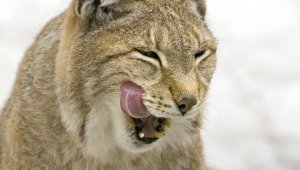Especially when dealing with bears, large crowds gathering at the scene of the conflict lower the chances of scaring the animal off safely, which means that the presence of outsiders puts the animal's life in danger. People should follow instructions given by the police and stay away from the area.
When a large carnivore is injured or it is moving near populated areas, trackers with their dogs are urgently needed. This is why every regional game management association in Finland has assigned three SRVA officers who provide official assistance to the police in these situations. When a call for official aid comes through, the SRVA officer alerts a patrol consisting of hunters and hunting dogs to the scene.
When a conflict situation arises that involves a large carnivore, the police cooperate with SRVA (Suurristavirka-apu), a volunteer-based organisation that provides official assistance in matters related to large game animals. The police are in charge of the situation, but they need the expertise of trained and experienced hunters to track down the large carnivore and drive it back into the woods or – if all else fails – to put it down. Tracking a wounded large carnivore, especially a bear, is always dangerous, which is why these situations require an experienced dog handler and dog. Indeed, dogs are the most important tool in resolving large carnivore conflicts.
Simply sighting a large carnivore does not necessarily mean that the situation requires active SRVA operations. A large carnivore will usually try to avoid contact with people. If you see a large carnivore or spot its tracks, you should report the sighting to the large carnivore contact person of the local game management association.
The Finnish police are capable of reacting to sudden, acute situations that develop quickly and are threatening or dangerous to human lives or health and where there is no time to consider how the Hunting Act or Hunting Decree could be applied. If the situation is not urgent, applications for exceptional hunting permits can be submitted to the Finnish Wildlife Agency. Such a permit to kill a large carnivore may be granted if no other satisfactory solution for preventing the damages can be found or if the alternative solutions have not been able to prevent the damages caused by the animal. In order to receive compensation for damages to domestic animals, the owner of the animals must report the incidents to the local rural affairs authorities.
Road accidents involving large carnivores must be reported
If you get into a road accident with a large carnivore, always call the emergency exchange (112). Do not leave the car, as an injured large carnivore is dangerous and can act erratically. Road accidents that involve a large predator require special SRVA operations supervised by the police.
Read more about SRVA activities (riista.fi, in Finnish)
Read more about what you should do if you get into an accident with a large carnivore (riista.fi)
